Trace-Element Distribution on Sulfide Mineralization in Trento Province, NE Italy
Abstract
:1. Introduction
2. Materials and Methods
2.1. Geological Outlines
2.2. Hand-Specimen Description
2.3. Analytical Methods
3. Results
3.1. Bulk Rock Analyses
3.2. Results of In Situ (SEM) Analyses
4. Discussion
5. Conclusions
Author Contributions
Funding
Acknowledgments
Conflicts of Interest
References
- Brusca, C.; Perna, G. Inquadramento e Genesi dei Giacimenti di Galena Argentifera del Monte Calisio (Trento). In Proceedings of the Atti del Convegno “II Monte Calisio e L’argento delle Alpi Dall’antichità al XVIII Secolo, Giacimenti, Storia e Rapporti con la Tradizione Mineraria Mitteleuropea“, Civezzano, Italy, 14–15 October; 1995; pp. 19–30. [Google Scholar]
- Cook, N.J.; Ciobanu, C.L.; Pring, A.; Skinner, W.; Shimizu, M.; Danyushevsky, L.; Saini-Eidukat, B.; Melcher, F. Trace and minor elements in sphalerite: A LA-ICPMS study. Geochim. Cosmochim. Acta 2009, 73, 4761–4791. [Google Scholar] [CrossRef]
- Cook, N.J.; Etschmann, B.; Ciobanu, C.L.; Geraki, K.; Howard, D.L.; Williams, T.; Rae, N.; Pring, A.; Chen, G.; Johannessen, B.; et al. Distribution and Substitution Mechanism of Ge in a Ge–(Fe)-Bearing Sphalerite. Minerals 2015, 5, 117–132. [Google Scholar] [CrossRef]
- Cook, N.J.; Ciobanu, C.L.; George, L.; Zhu, Z.-Y.; Wade, B.; Ehrig, K. Trace Element Analysis of Minerals in Magmatic-Hydrothermal Ores by Laser Ablation Inductively-Coupled Plasma Mass Spectrometry: Approaches and Opportunities. Minerals 2016, 6, 111. [Google Scholar] [CrossRef]
- Junge, M.; Oberthür, T.; Melcher, F. Cryptic variation of chromite chemistry, platinum-group-element and —mineral distribution in the UG-2 chromitite—An example from the Karee Mine, western Bushveld Complex, South Africa. Econ. Geol. 2014, 109, 795–810. [Google Scholar] [CrossRef]
- Junge, M.; Wirth, R.; Oberthür, T.; Melcher, F.; Schreiber, A. Mineralogical siting of platinum-group elements in pentlandite from the Bushveld Complex, South Africa. Miner. Depos. 2015, 50, 41–54. [Google Scholar] [CrossRef]
- Goldmann, S.; Junge, M.; Wirth, R.; Schreiber, A. Distribution of trace elements in sphalerite and arsenopyrite on the nanometre-scale—discrete phases versus solid solution. Eur. J. Mineral. 2018, 31, 325–333. [Google Scholar] [CrossRef]
- Ye, L.; Cook, L.; Ciobanu, C.L.; Yuping, L.; Qian, Z.; Tiegeng, K.; Wei, G.; Yulong, L.; Danyushevskiy, L. Trace and minor elements in sphalerite from base metal deposits in South China: A LA-ICPMS study. Ore Geol. Rev. 2011, 39, 188–217. [Google Scholar] [CrossRef]
- Sassi, F.P.; Cesare, B.; Mazzoli, C.; Peruzzo, L.; Sassi, R.; Spiess, R. The crystalline basements of the Italian eastern Alps: A review of the metamorphic features. Period. Di Mineral. 2004, 73, 23–42. [Google Scholar]
- Spiess, R.; Cesare, B.; Mazzoli, C.; Sassi, R.; Sassi, F.P. The crystalline basement of the Adria microplate in the eastern Alps: A review of the palaeostructural evolution from the Neoproterozoic to the Cenozoic. Rend. Lincei 2010, 21, 31–50. [Google Scholar] [CrossRef]
- Rottura, A.; Bargossi, G.M.; Caggianelli, A.; Del Moro, A.; Visonà, D.; Tranne, C.A. Origin and significance of the Permian high-K calc-alkaline magmatism in the central-eastern Southern Alps. Italy. Lithos 1998, 45, 329–348. [Google Scholar] [CrossRef]
- Willcock, M.A.W.; Cas, R.A.F.; Giordano, G.; Morelli, C. The eruption. pyroclastic flow behaviour. and caldera in-filling processes of the extremely large volume (>1290 km3). intra- to extra-caldera. Permian Ora (Ignimbrite) Formation. Southern Alps. Italy. J. Volcanol. Geotherm. Res. 2013, 265, 102–126. [Google Scholar] [CrossRef]
- Bosellini, A.; Gianolla, P.; Stefani, M. The Triassic Carbonate Platforms of the Dolomites (Northern Italy): Their Evolution and Stratigraphic Framework. Mem. Di Sci. Geol. 2003, 54, 111–185. [Google Scholar]
- Avanzini, M.; Bargossi, G.M.; Borsato, A.; Selli, L. Note iIllustrative Della Carta Geologica d’Italia Alla Scala 1:50,000; ISPRA-Servizio Geologico d’Italia: Trento, Italy, 2010; p. 060. [Google Scholar]
- Bianchini, G.; Natali, C.; Shibata, T.; Yoshikawa, M. Basic Dykes Crosscutting the Crystalline Basement of Valsugana (Italy): New Evidence of Early Triassic Volcanism in the Southern Alps. Tectonics 2018, 37, 2080–2093. [Google Scholar] [CrossRef]
- Nimis, P.; Omenetto, P.; Giunti, I.; Artioli, G.; Angelini, I. Lead isotope systematics in hydrothermal sulphide deposits from the centraleastern Southalpine (northern Italy). Eur. J. Mineral. 2012, 24, 23–37. [Google Scholar] [CrossRef]
- Artioli, G.; Angelini, I.; Tecchiati, U.; Pedrotti, A. Eneolithic copper smelting slags in the Eastern Alps: Local patterns of metallurgical exploitation in the Copper Age. J. Archaeol. Sci. 2015, 63, 78–83. [Google Scholar] [CrossRef]
- Murara, G. Le Mineralizzazioni a Solfuri Misti Nelle Vulcaniti Atesine, Formazione Andesitica, Dell’alta Val Fersina (Trentino). In Atti del Symposium Internazionale sui Giacimenti Minerari delle Alpi Atti del Symposium Internazionale sui Giacimenti Minerari delle Alpi; Regione Trentino Alto Adige e CCIA: Trento, Italy, 1966; Volume 2, pp. 471–493. [Google Scholar]
- Barillari, A.; Jobstraibizer, P.G.; Omenetto, P. II Giacimento a Piombo, Zinco e Rame di Cinque Valli in Valsugana (Trentino). In Atti del Symposium Internazionale sui Giacimenti Minerari delle Alpi; Regione Trentino Alto Adige e CCIA: Trento, Italy, 1966; Volume 3, pp. 769–791. [Google Scholar]
- Shiga, Y.; Urashima, Y. Isomorphous compounds; Galena Clausthalite, and altaite from the Kushikino gold-silver ore deposit, Japan-possible substitutional limits. Min. Geol. 1989, 39, 253–260. [Google Scholar]
- Seryotkin, Y.V.; Pal’yanov, G.A.; Savva, N.E. Sulfur–selenium isomorphous substitution and morphotropic transition in the Ag3Au(Se,S)2 series. Russ. Geol. Geophys. 2013, 54, 646–651. [Google Scholar] [CrossRef]
- Bullock, L.A.; Perez, M.; Armstrong, J.G.; Parnell, J.; Still, J.; Feldmann, J. Selenium and tellurium resources in Kisgruva Proterozoic volcanogenic massive sulphide deposit (Norway). Ore Geol. Rev. 2018, 99, 411–424. [Google Scholar] [CrossRef]
- Radková, A.B.; Jamieson, H.; Llinská-Voleková, B.; Majzlan, J.; Števko, M.; Chovan, M. Mineralogical controls on antimony and arsenic mobility during tetrahedrite-tennantite weathering at historic mine sites Špania Dolina-Piesky and Ľubietová-Svätodušná, Slovakia. Am. Mineral. 2017, 102, 1091–1100. (In Slovak) [Google Scholar]
- Cheng, Y.; Spandler, C.; Kemp, A.; Mao, J.; Rusk, B.; Hu, Y.; Blake, K. Controls on cassiterite (SnO2) crystallization: Evidence from cathodoluminescence, trace-element chemistry, and geochronology at the Gejiu Tin District. Am. Mineral. 2019, 104, 118–129. [Google Scholar] [CrossRef]
- Pons, M.-L.; Debret, B.; Bouilhol, P.; Delacour, A.; Williams, H. Zinc isotope evidence for sulfate-rich fluid transfer across subduction zones. Nat. Commun. 2016, 7, 13794. [Google Scholar] [CrossRef] [PubMed]
- Giuli, G.; Paris, E.; Wu, Z.; De Panfilis, S.; Pratesi, G.; Cipriani, G. 2005The Structural Role of Ag in Galena (PbS). A XANES Study. Phys. Scr. 2005, T115, 387–389. [Google Scholar] [CrossRef]
- Pažout, R.; Sejkora, J.; Šrein, V. Ag-Pb-Sb Sulfosalts and Se-rich Mineralization of Anthony of Padua Mine near Poličany—Model Example of the Mineralization of Silver Lodes in the Historic Kutná Hora Ag-Pb Ore District, Czech Republic. Minerals 2019, 9, 430. [Google Scholar] [CrossRef]
- Amcoff, O. Distribution of silver in massive sulfide ores. Miner. Depos. 1984, 19, 63–69. [Google Scholar] [CrossRef]
- Chutas, N.I.; Kress, V.C.; Ghiorso, M.S.; Sack, R.O. A solution model for high-temperature PbS-AgSbS2-AgBiS2 galena. Am. Mineral. 2008, 93, 1630–1640. [Google Scholar] [CrossRef]
- Sack, R.O.; Loucks, R. Thermodynamic properties of tetrahedrite-tennantites: Constraints on the interdependence of the Ag↔Cu. Fe↔Zn. Cu↔Fe. and As↔Sb exchange reactions. Am. Mineral. 1985, 70, 1270–1289. [Google Scholar]
- Arlt, T.; Diamond, L.W. Composition of tetrahedrite-tennantite and ‘schwazite’ in the Schwaz silver mines. North Tyrol, Austria. Mineral. Mag. 1998, 62, 801–820. [Google Scholar] [CrossRef]
- George, L.L.; Cook, N.J.; Ciobanu, C.L. Minor and trace elements in natural tetrahedrite-tennantite: Effects on element partitioning among base metal sulphides. Minerals 2017, 7, 17. [Google Scholar] [CrossRef]
- Lynch, J.V.G. Large-scale hydrothermal zoning reflected in the tetrahedrite-freibergite solid solution. Keno hill Ag–Pb–Zn district, Yukon. Can. Mineral. 1989, 27, 383–400. [Google Scholar]
- Sack, R.O.; Lynch, J.V.G.; Foit, F. Fahlore as a petrogenetic indicator: Keno Hill Ag–Pb–Zn District. Yukon. Canada. Mineral. Mag. 2003, 67, 1023–1038. [Google Scholar] [CrossRef]
- Catchpole, H.; Kouzmanov, K.; Fontboté, L. Copper-excess stannoidite and tennantite-tetrahedrite as proxies for hydrothermal fluid evolution in a zoned cordilleran base metal district. Morococha. central Peru. Can. Mineral. 2012, 50, 719–743. [Google Scholar] [CrossRef]
- Sack, R.O. Note on “large-scale hydrothermal zoning reflected in the tetrahedrite-freibergite solid solution. Keno Hill Ag–Pb–Zn district. Yukon” by J.V. Gregory Lynch. Can. Mineral. 2002, 40, 1717–1719. [Google Scholar] [CrossRef]
- Hernández, A.N.G.; Akasaka, M. Ag-rich tetrahedrite in the El Zancudo deposit, Colombia: Occurrence. chemical compositions and genetic temperatures. Resour. Geol. 2010, 218–233. [Google Scholar] [CrossRef]
- Keim, M.F.; Walter, B.F.; Neumann, U.; Kreissl, S.; Bayerl, R.; Markl, G. Polyphase enrichment and redistribution processes in silver-rich mineral associations of the hydrothermal fluorite-barite-(Ag–Cu) Clara deposit. SW Germany. Miner. Depos. 2018, 54, 155–174. [Google Scholar] [CrossRef]
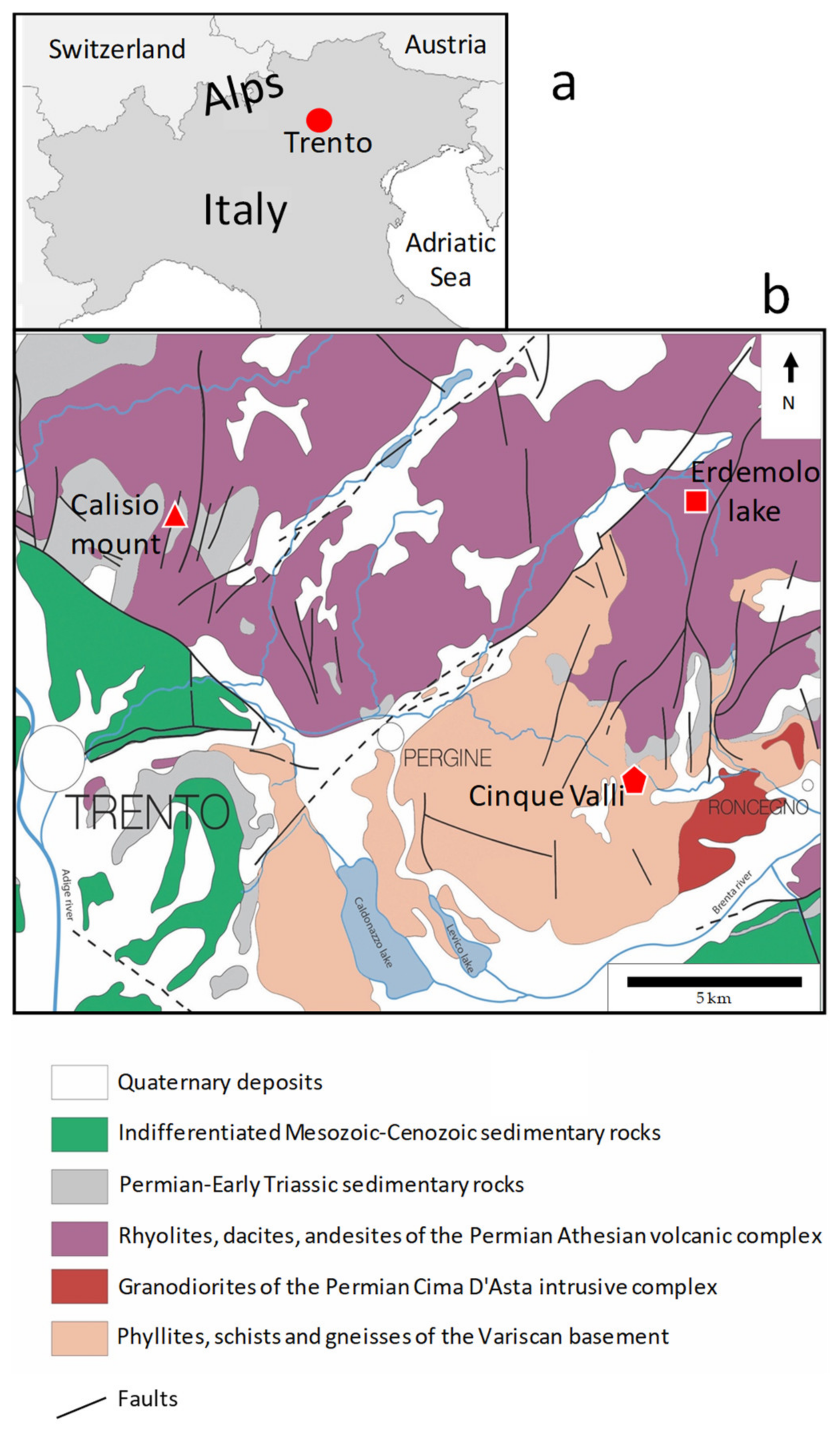
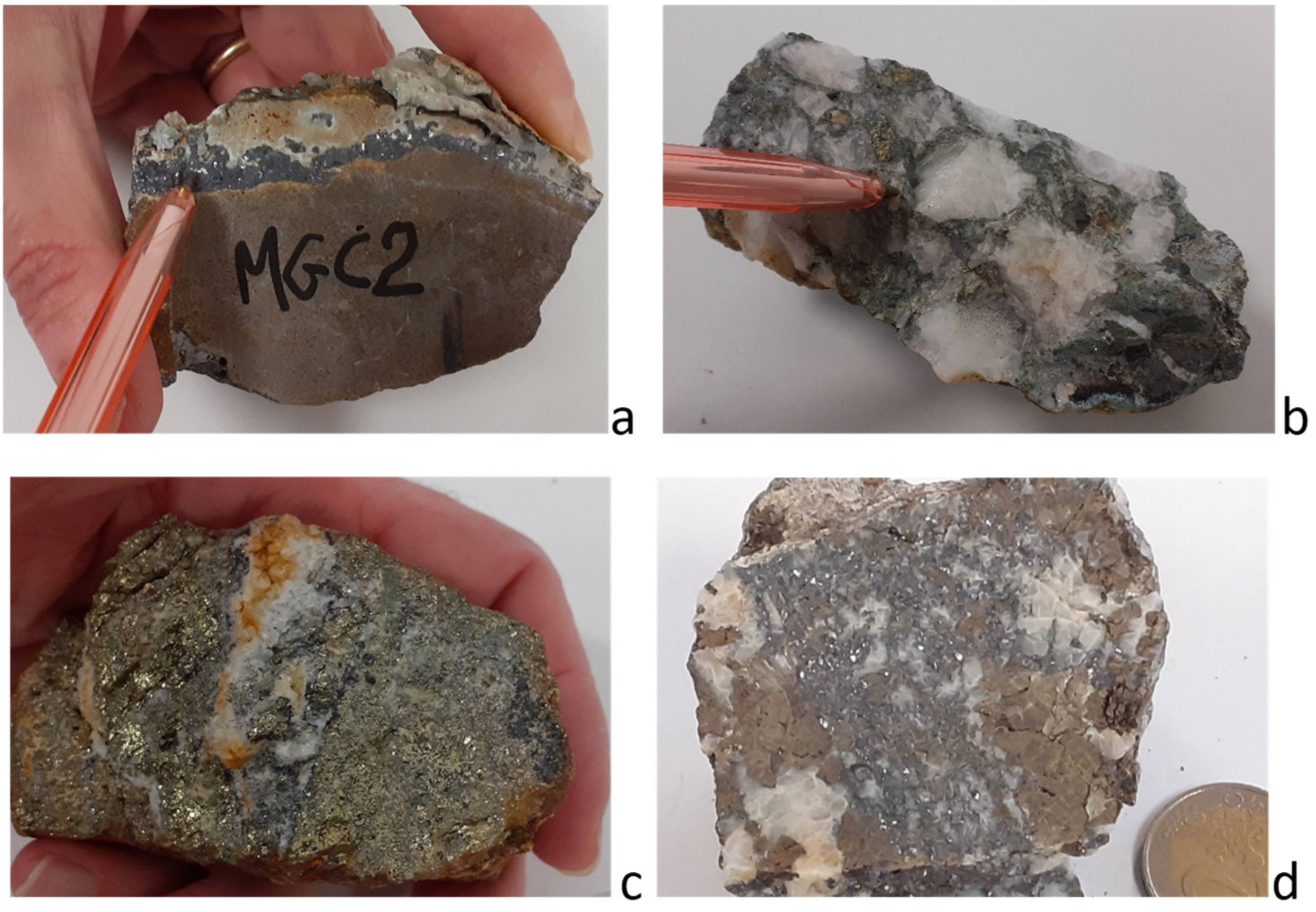
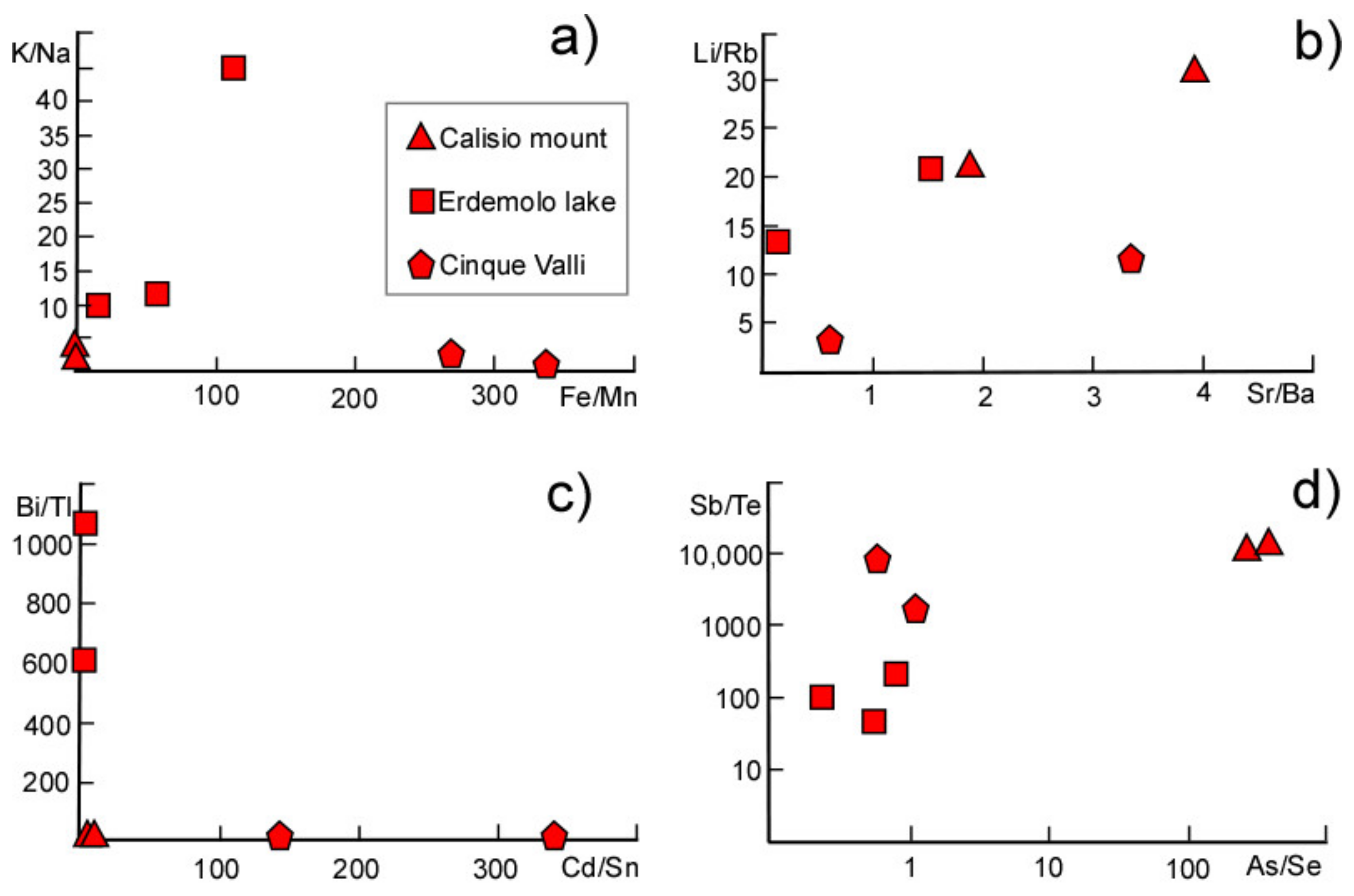
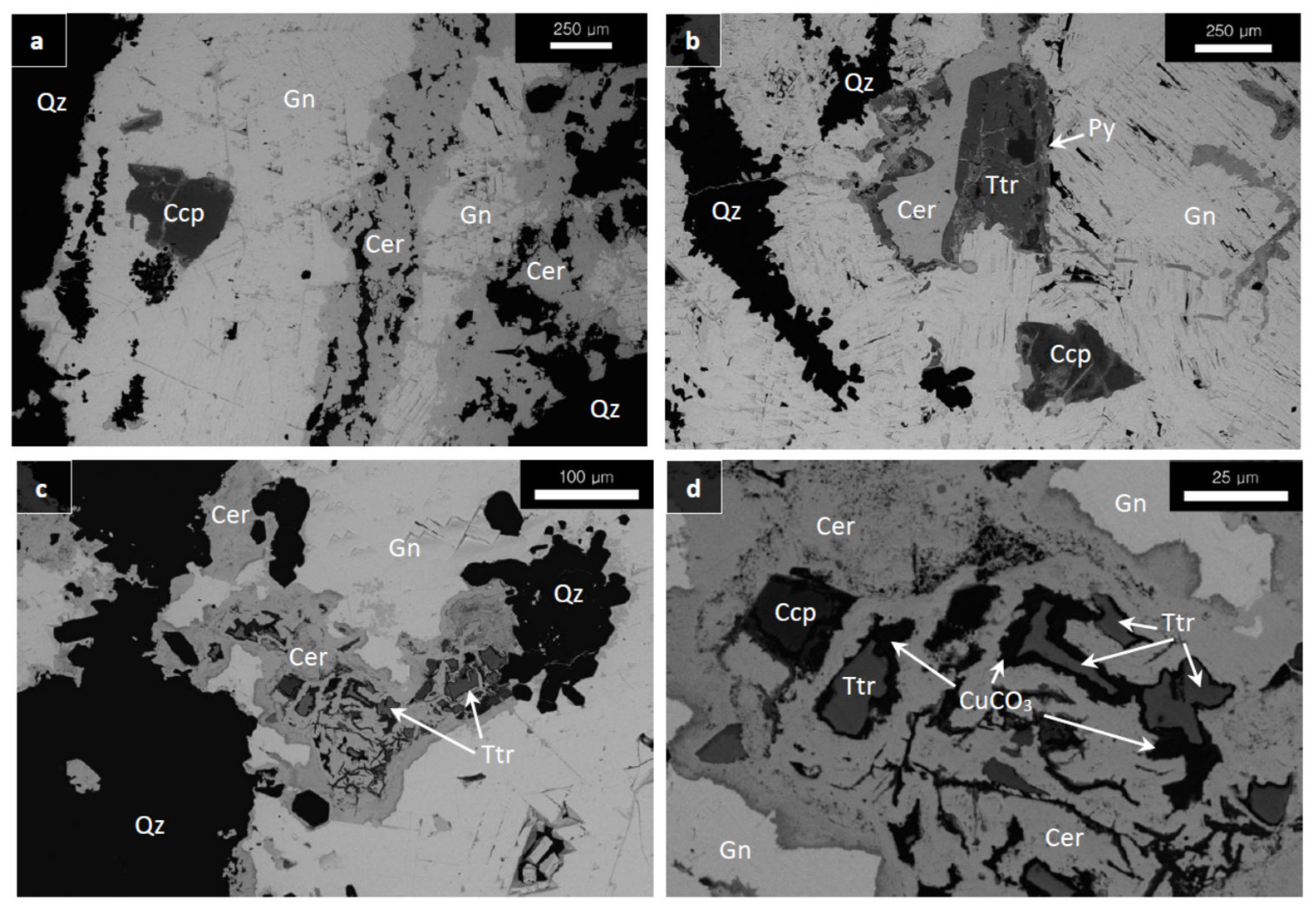
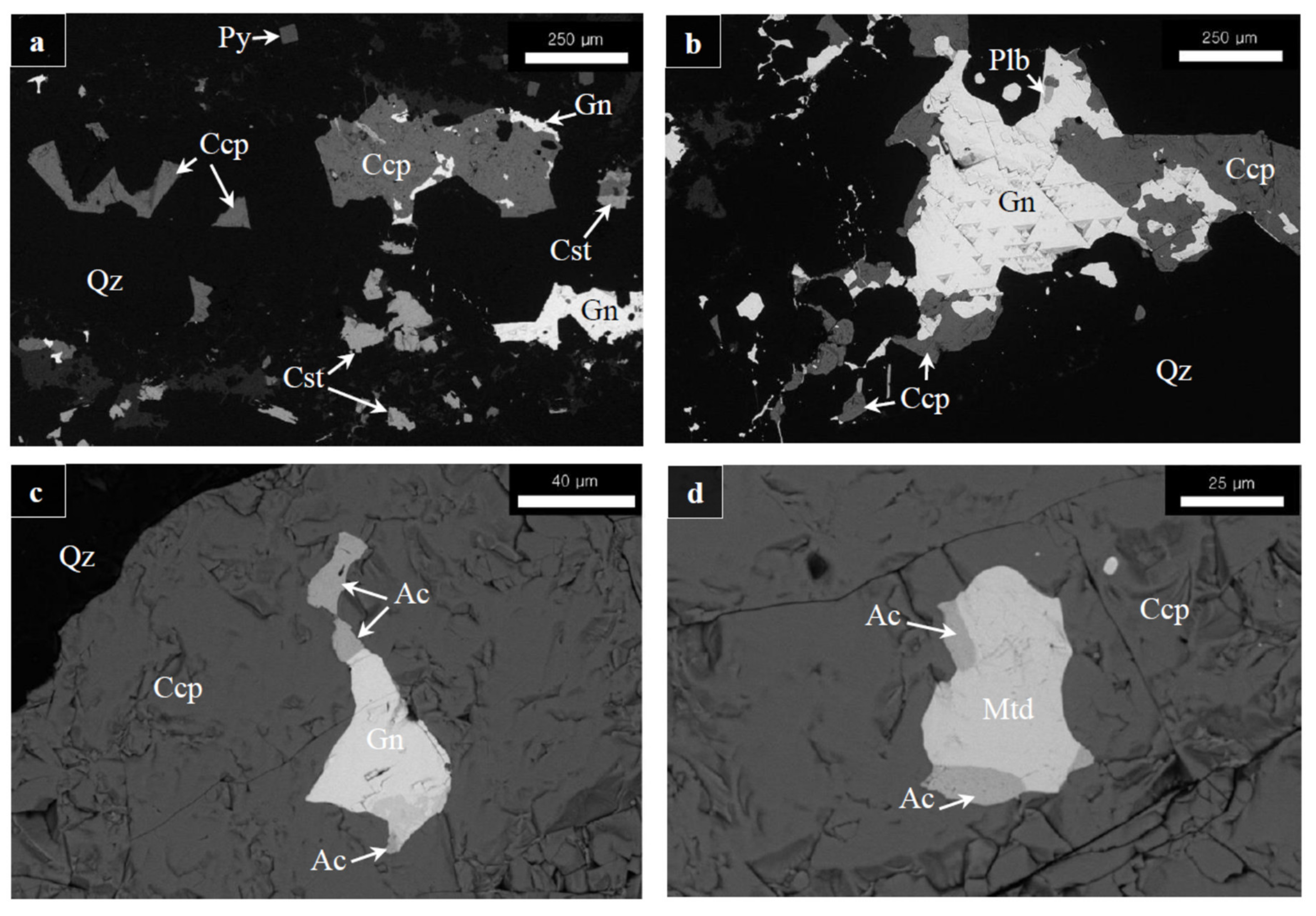

| Analyzed | Calisio Mount | Erdemolo Lake | Cinque Valli | ||||
|---|---|---|---|---|---|---|---|
| Element | MGC1 | MGC2 | MGE1 | MGE3 | MGE5 | MGV2 | MGV3 |
| Ca | 288,513 | 321,530 | 7804 | 29,572 | 509 | 140 | 2005 |
| Mg | 85,595 | 67,562 | 2271 | 3242 | 4076 | 45.8 | 684 |
| Al | 1891 | 618 | 16,143 | 19,264 | 23,388 | 995 | 4679 |
| Na | 114 | 180 | 44.1 | 116 | 26.2 | 120 | 3838 |
| K | 308 | 158 | 497 | 1173 | 1177 | 283 | 2194 |
| Li | 56.2 | 19.4 | 51.5 | 182 | 47.8 | 30.7 | 48.4 |
| Rb | 1.83 | 0.93 | 3.03 | 8.71 | 3.62 | 2.61 | 14.3 |
| Sr | 62.8 | 210 | 2.37 | 7.13 | 1.06 | 1.62 | 5.39 |
| Ba | 16.0 | 111 | n.d. | 4.71 | 7.04 | 0.49 | 8.58 |
| P | 44.9 | 41.1 | 65.8 | 81.4 | 194 | 19.1 | 25.0 |
| B | 28.7 | 24.3 | 13.4 | 31.2 | n.d. | 0.86 | 9.88 |
| Be | 0.29 | 0.25 | 0.26 | 0.48 | 0.11 | 0.30 | 0.60 |
| Fe | 21,098 | 18,607 | 79,475 | 41,450 | 303,616 | 3402 | 3059 |
| Mn | 13,340 | 6906 | 1435 | 2500 | 2709 | 12.6 | 9.08 |
| Ti | 38.6 | 16.1 | 74.2 | 92.0 | 220 | 2.78 | 10.1 |
| Cu | 1376 | 791 | 24,434 | 15,398 | 191,530 | 1132 | 374 |
| Zn | 260 | 259 | 90,692 | 24,671 | 793 | 232,752 | 271,351 |
| Pb | 56,276 | 137,048 | 101,981 | 61,735 | 1249 | 74,273 | 38,476 |
| Ag | 142 | 50.7 | 64.0 | 311.4 | 51.7 | 118 | 69.3 |
| Sb | 602 | 670 | 38.1 | 30.7 | 38.0 | 691 | 194 |
| Bi | 0.25 | 0.35 | 176 | 47.2 | 59.1 | 1.40 | 0.31 |
| As | 278 | 86.7 | 34.8 | 5.95 | 42.7 | 1.78 | 3.14 |
| Cd | 7.2 | 4.2 | 409 | 150 | 5.06 | 648 | 737 |
| Sn | 0.58 | 0.48 | 61.2 | 42.1 | 111 | 4.47 | 2.16 |
| Ga | 0.47 | 2.03 | 2.30 | 3.09 | 4.81 | 59.0 | 61.0 |
| Se | 0.69 | 0.32 | 61.0 | 25.0 | 52.2 | 2.86 | 2.74 |
| Te | 0.05 | 0.06 | 0.83 | 0.31 | 0.17 | 0.08 | 0.10 |
| Sc | 1.23 | 0.44 | 1.21 | 3.34 | 5.23 | n.d. | n.d. |
| V | 1.22 | 1.23 | 5.22 | 9.85 | 17.1 | n.d. | 2.24 |
| Cr | 1.59 | 0.94 | 3.17 | 4.37 | 8.87 | 0.35 | 0.57 |
| Co | 5.23 | 10.4 | 10.7 | 6.06 | 17.0 | 21.2 | 24.4 |
| Ni | 73.0 | 75.9 | 2.89 | 8.63 | 2.48 | 0.44 | 1.46 |
| Mo | 0.02 | 0.68 | 0.21 | 0.42 | 1.69 | 1.95 | 2.65 |
| Tl | 0.28 | 0.59 | 0.17 | 0.08 | n.d. | 0.22 | 0.06 |
| U | 0.60 | 0.76 | 0.08 | 0.12 | 0.25 | n.d. | 0.04 |
| wt % | Galena | wt % | Cerussite | ||||||||||||||||||||||||||
| S | 13.1 | 12.65 | 12.55 | 12.71 | 12.37 | 12.35 | C | 8.48 | 9.46 | 10.03 | 10.02 | 8.99 | |||||||||||||||||
| Ag | 0.46 | - | - | - | - | 0.20 | O | 27.53 | 29.88 | 31.25 | 31.22 | 28.77 | |||||||||||||||||
| Pb | 86.44 | 87.35 | 87.45 | 87.29 | 87.63 | 87.45 | Pb | 63.99 | 60.66 | 58.73 | 58.76 | 62.24 | |||||||||||||||||
| Total | 100 | 100 | 100 | 100 | 100 | 100 | Total | 100 | 100 | 100 | 100 | 100 | |||||||||||||||||
| wt % | Tetrahedrite-Tennantite | ||||||||||||||||||||||||||||
| S | 25.45 | 24.62 | 23.03 | 25.9 | 24.88 | 23.55 | 23.15 | 24.82 | 25.02 | 25.93 | |||||||||||||||||||
| Fe | 0.38 | 1.26 | 0.61 | 0.37 | 0.48 | 0.51 | 0.51 | - | - | - | |||||||||||||||||||
| Cu | 31.87 | 32.09 | 27.53 | 31.58 | 31.29 | 26.19 | 27.11 | 31.17 | 30.65 | 31.42 | |||||||||||||||||||
| Zn | 6.41 | 5.86 | 5.63 | 6.56 | 6.11 | 5.64 | 6.19 | 6.34 | 5.72 | 6.44 | |||||||||||||||||||
| As | 7.60 | 10.55 | 3.82 | 15.91 | 14.53 | - | 4.55 | 7.53 | 11.86 | 8.74 | |||||||||||||||||||
| Ag | 2.66 | 1.09 | 4.98 | - | 0.97 | 8.04 | 4.65 | 2.33 | 2.32 | 3.73 | |||||||||||||||||||
| Sb | 15.65 | 9.9 | 19.11 | 3.35 | 4.74 | 22.05 | 18.56 | 16.04 | 8.46 | 13.53 | |||||||||||||||||||
| Pb | 9.97 | 14.63 | 15.29 | 16.33 | 17.00 | 14.02 | 15.29 | 11.77 | 15.97 | 10.21 | |||||||||||||||||||
| Total | 100 | 100 | 100 | 100 | 100 | 100 | 100 | 100 | 100 | 100 | |||||||||||||||||||
| wt % | Chalcopyrite | ||||||||||||||||||||||||||||
| S | 38.15 | 38.04 | 38.36 | 37.59 | 41.65 | 39.37 | 40.02 | 38.19 | 40.60 | ||||||||||||||||||||
| Fe | 28.81 | 28.64 | 28.24 | 29.46 | 27.27 | 26.81 | 27.46 | 28.38 | 27.79 | ||||||||||||||||||||
| Cu | 33.04 | 33.32 | 33.40 | 32.95 | 31.09 | 33.83 | 32.52 | 33.43 | 31.62 | ||||||||||||||||||||
| Total | 100 | 100 | 100 | 100 | 100 | 100 | 100 | 100 | 100 | ||||||||||||||||||||
| wt % | Galena | ||||||||||||||
| S | 13.13 | 13.17 | 13.42 | 13.62 | 13.37 | 13.48 | 13.27 | 12.81 | 13.19 | 12.94 | 15.31 | ||||
| Ag | 0.27 | 0.61 | 0.44 | 1.17 | 1.34 | 1.84 | 1.90 | 0.25 | - | 0.29 | 0.11 | ||||
| Pb | 86.6 | 86.23 | 86.14 | 85.21 | 85.29 | 84.68 | 84.83 | 86.93 | 86.81 | 86.77 | 84.57 | ||||
| Total | 100 | 100 | 100 | 100 | 100 | 100 | 100 | 100 | 100 | 100 | 100 | ||||
| wt % | Chalcopyrite | wt % | Sphalerite | wt % | Acanthite | ||||||||||
| S | 35.74 | 35.41 | S | 36.37 | 30.16 | 38.09 | S | 13.96 | 17.92 | 13.77 | 16.99 | ||||
| Fe | 30.64 | 29.65 | Fe | 0.93 | 2.34 | 1.29 | Ag | 86.04 | 82.08 | 86.23 | 83.01 | ||||
| Cu | 33.62 | 34.95 | Zn | 62.7 | 67.5 | 60.63 | Total | 100 | 100 | 100 | 100 | ||||
| Total | 100 | 100 | Total | 100 | 100 | 100 | |||||||||
| wt % | Sulfosalts | ||||||||||||||
| S | 19.71 | 21.11 | 20.99 | 17.05 | |||||||||||
| Cu | - | - | - | 3.52 | |||||||||||
| Ag | 22.57 | 29.66 | 29.3 | 72.37 | |||||||||||
| Pb | 21.95 | - | - | - | |||||||||||
| Sb | - | - | - | 7.06 | |||||||||||
| Bi | 35.77 | 49.24 | 49.71 | - | |||||||||||
| Total | 100 | 100 | 100 | 100 | |||||||||||
© 2019 by the authors. Licensee MDPI, Basel, Switzerland. This article is an open access article distributed under the terms and conditions of the Creative Commons Attribution (CC BY) license (http://creativecommons.org/licenses/by/4.0/).
Share and Cite
Bianchini, G.; Natali, C.; Ferretti, P.; Casagrande, L.; Conedera, M.; Marchina, C. Trace-Element Distribution on Sulfide Mineralization in Trento Province, NE Italy. Minerals 2019, 9, 736. https://doi.org/10.3390/min9120736
Bianchini G, Natali C, Ferretti P, Casagrande L, Conedera M, Marchina C. Trace-Element Distribution on Sulfide Mineralization in Trento Province, NE Italy. Minerals. 2019; 9(12):736. https://doi.org/10.3390/min9120736
Chicago/Turabian StyleBianchini, Gianluca, Claudio Natali, Paolo Ferretti, Lara Casagrande, Manuel Conedera, and Chiara Marchina. 2019. "Trace-Element Distribution on Sulfide Mineralization in Trento Province, NE Italy" Minerals 9, no. 12: 736. https://doi.org/10.3390/min9120736
APA StyleBianchini, G., Natali, C., Ferretti, P., Casagrande, L., Conedera, M., & Marchina, C. (2019). Trace-Element Distribution on Sulfide Mineralization in Trento Province, NE Italy. Minerals, 9(12), 736. https://doi.org/10.3390/min9120736







